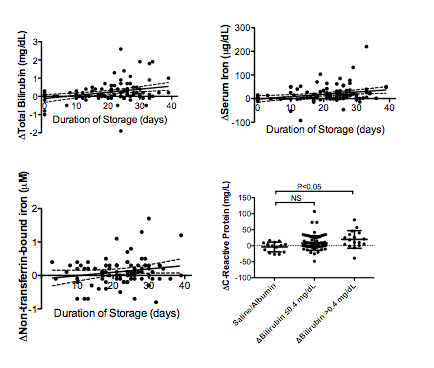Abstract
BACKGROUND: Current FDA standards allow refrigerated red blood cell (RBC) units to be stored for up to 42 days before transfusion; these are based on several criteria, including that, on average, <25% of the RBCs transfused into healthy volunteers will be cleared from the circulation in the first 24 hours. However, the 24-hour post-transfusion RBC recovery is less in ill adult patients than in healthy adult volunteers, an issue that has not yet been studied in pediatric patients.
AIMS: To compare the effects of transfusion of packed RBCs after various storage durations on iron metabolism, hemolysis, and inflammation.
METHODS: In this prospective observational study, we recruited 73 transfused critically-ill children. Blood samples were collected before and 4-hours after a RBC transfusion. Furthermore, as a control, blood samples were similarly collected in 14 critically-ill children infused with saline or albumin for volume replacement. Plasma non-transferrin bound iron (NTBI) was quantified by an ultrafiltration assay, serum hepcidin levels by an immunoassay, free hemoglobin by Drabkin's assay, and other routine laboratory parameters by standard methods. Correlations and the effect of covariates were determined by linear regression. Difference between means was assessed by one-way ANOVA.
RESULTS: The median storage duration of transfused RBCs was 24 days (range: 4-39 days). RBC storage duration was significantly and positively associated with increases in total bilirubin (R2=0.12; P<0.01) and serum iron (R2=0.11; P<0.01), with a positive trend in NTBI (R2=0.04; P=0.07) (see Figure) and a negative trend in haptoglobin levels (R2=0.03; P=0.09; not shown). No association was observed between storage duration and increases in plasma hemoglobin, hepcidin, or C-reactive protein (CRP). These data suggest that, in critically-ill children, RBC storage duration alone relatively poorly predicts the extent of hemolysis observed after transfusion, explaining only ~10% of the variability. Four hours after transfusion, measures of inflammation were not significantly associated with RBC storage duration. Nonetheless, a subset of patients (17 of 73) with a greater extent of hemolysis (defined by an increase in total bilirubin >0.4 mg/dL) developed a significant increase in CRP relative to the saline/albumin infused controls (i.e., a mean increase of 23.5 [3.7-43.4] mg/L; P<0.05; see Figure). A similar result was obtained using an indirect bilirubin threshold of >0.2 mg/dL (i.e., a mean increase in CRP of 22.4 [3.0-41.8] mg/L relative to the saline/albumin infused controls). These results suggest that increases in bilirubin above a certain post-hoc threshold may be predictive of an acute phase response. Finally, transfusion of irradiated RBC units trended towards increased post-transfusion bilirubin levels (P=0.08).
CONCLUSIONS: The main conclusion of this study is that increased RBC storage duration results in a variable amount of both intra- and extra-vascular hemolysis. Although circulating haptoglobin levels in transfusion recipients decreased somewhat with increasing storage duration, haptoglobin was not completely consumed and free hemoglobin was absent 4-hours after transfusion. Nonetheless, post-transfusion levels of circulating bilirubin, iron, and NTBI did increase after prolonged RBC storage. In addition, the extent of hemolysis, evidenced by increased serum bilirubin levels above a certain threshold, predicted an acute phase response in critically-ill children. Importantly, storage duration alone poorly predicted post-transfusion consequences resulting from the RBC storage lesion, explaining, for example, only 10% of the variability in the degree of hemolysis in critically-ill pediatric patients. This suggests that other, as yet unknown, donor and recipient factors play a more significant role in this setting. If hemolysis of transfused refrigerator storage-damaged RBCs induces adverse clinical sequelae, this suggests that randomized studies aimed at studying the role of RBC storage duration on patient outcome may be underpowered, if they assume that storage duration alone is the most suitable predictor of outcome.
No relevant conflicts of interest to declare.
Author notes
Asterisk with author names denotes non-ASH members.


This feature is available to Subscribers Only
Sign In or Create an Account Close Modal